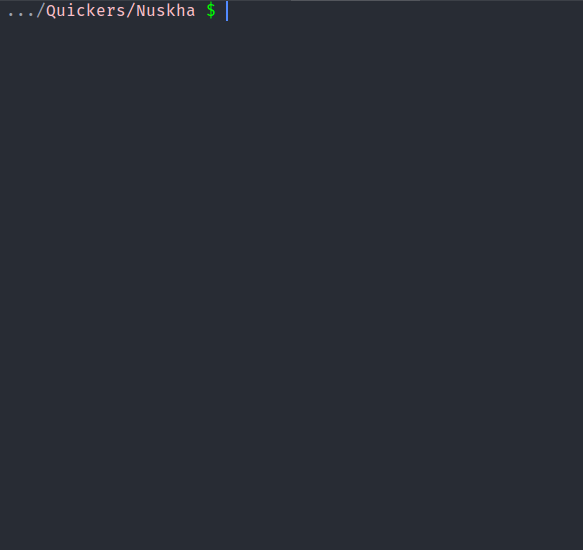How to clear the eshell
Emacs Asked by Startec on December 24, 2020
After looking at this answer I find it hard to believe there is no way to clear the eShell.
Does anybody know of a short function or method to delete the entire buffer. Pressing C-l just scrolls the text, as soon as enter is pressed all of that text comes back.
Thanks
6 Answers
I use make eshell buffers and I rename them accordingly. So a slight modification to @scribe's answer works perfectly on eshell buffers with anyname.
(defun run-this-in-eshell (cmd)
"Runs the command 'cmd' in eshell."
(end-of-buffer)
(eshell-kill-input)
(message (concat "Running in Eshell: " cmd))
(insert cmd)
(eshell-send-input)
(end-of-buffer)
(eshell-bol)
(yank))
(add-hook 'eshell-mode-hook (lambda ()
(interactive)
(local-set-key (kbd "C-l")
(run-this-in-eshell "clear 1"))))
Answered by soumya ranjan Tripathy on December 24, 2020
The doc string of eshell/clear says:
(eshell/clear &optional SCROLLBACK)
Scroll contents of eshell window out of sight, leaving a blank window. If SCROLLBACK is non-nil, clear the scrollback contents.
So call clear t on the Eshell prompt to clear all Eshell buffer contents.
For binding of the command to a key you can use something like the following in eshell-mode-hook:
(local-set-key (kbd "C-<backspace>") (lambda () (interactive) (eshell/clear 1)))
This answer is similar to scribe's answer and I initially wanted just to comment that one. But, then I thought that this answer goes a bit further. It also gives you a hint on how to use Eshell commands and how to discover their comments yourself.
Answered by Tobias on December 24, 2020
Running clear with 1, as in clear 1 works.
How could you have found this out? We know we want to look for a function about eshell and it has to do with clear. So, why not do C-h f and type eshell clear. This produces two functions:
eshell/clear-scrollbackeshell/clear
If we select eshell-scrollback, Emacs shows us usage:
eshell/clear-scrollback is a compiled Lisp function in ‘esh-mode.el’.
(eshell/clear-scrollback)
Clear the scrollback content of the eshell window.
We try running eshell/clear-scrollback and it clears the screen. Ok, we can look at it's implementation but before that let's look at the other function eshell/clear. When we select that after C-h f and eshell clear, we get:
eshell/clear is an interactive compiled Lisp function in
‘esh-mode.el’.
(eshell/clear &optional SCROLLBACK)
Scroll contents of eshell window out of sight, leaving a blank window.
If SCROLLBACK is non-nil, clear the scrollback contents.
This tells us that we could run clear 1 to clear the screen. But, why are there two functions? If we look at the implementation of eshell/clear, we can see that the other function is actually used in it. To find the implementation simply click on the esh-mode.el in the usage buffer of eshell/clear.
(defun eshell/clear (&optional scrollback)
"Scroll contents of eshell window out of sight, leaving a blank window.
If SCROLLBACK is non-nil, clear the scrollback contents."
(interactive)
(if scrollback
(eshell/clear-scrollback)
(insert (make-string (window-size) ?n))
(eshell-send-input)))
You can see that at the end this function sends any input which was present at the time of clearing the screen. To get around it, I wrote this little function:
(defun run-this-in-eshell (cmd)
"Runs the command 'cmd' in eshell."
(with-current-buffer "*eshell*"
(end-of-buffer)
(eshell-kill-input)
(message (concat "Running in Eshell: " cmd))
(insert cmd)
(eshell-send-input)
(end-of-buffer)
(eshell-bol)
(yank)))
The benefits of this function are that if you put it in a lambda function and bind it to a key like this:
(bind-keys*
("C-<backspace>" . (lambda () ; clear shell
(interactive)
(run-this-in-eshell "clear 1"))))
It will first kill the current input, run clear 1 and then yank the input back. This way you can also clear eshell from any other buffer using the keybinding.
Some other functions provided will wipe out any buffer they are ran in. So if you used the keybinding to clear eshell from some other buffer, it will instead clear THAT buffer.
Answered by scribe on December 24, 2020
While there is a built-in eshell/clear in recent versions of Emacs, it does something rather unfortunate: when there is unsent input at the current prompt, clearing the buffer sends the input. This can be problematic if the user has entered partial input.
The following version will clear the buffer while preserving unsent input. This is more comint-like.
(defun *-eshell-clear ()
"Clear `eshell' buffer, comint-style."
(interactive)
(let ((input (eshell-get-old-input)))
(eshell/clear-scrollback)
(eshell-emit-prompt)
(insert input)))
Answered by Tianxiang Xiong on December 24, 2020
This does it to one, insted of two lines.
;Clear the eshell buffer.
(defun eshell/clear ()
(let ((eshell-buffer-maximum-lines 0)) (eshell-truncate-buffer)))
Typing clear in eshell will then result in clearing the buffer.
Answered by K.D.G on December 24, 2020
There is a function in the current development version, as you can see on the emacs-devel mailing list.
The function is very simple:
(defun eshell/clear ()
"Clear the eshell buffer."
(let ((inhibit-read-only t))
(erase-buffer)
(eshell-send-input)))
Typing clear in eshell will then result in clearing the buffer.
Answered by rekado on December 24, 2020
Add your own answers!
Ask a Question
Get help from others!
Recent Answers
- haakon.io on Why fry rice before boiling?
- Joshua Engel on Why fry rice before boiling?
- Jon Church on Why fry rice before boiling?
- Lex on Does Google Analytics track 404 page responses as valid page views?
- Peter Machado on Why fry rice before boiling?
Recent Questions
- How can I transform graph image into a tikzpicture LaTeX code?
- How Do I Get The Ifruit App Off Of Gta 5 / Grand Theft Auto 5
- Iv’e designed a space elevator using a series of lasers. do you know anybody i could submit the designs too that could manufacture the concept and put it to use
- Need help finding a book. Female OP protagonist, magic
- Why is the WWF pending games (“Your turn”) area replaced w/ a column of “Bonus & Reward”gift boxes?
